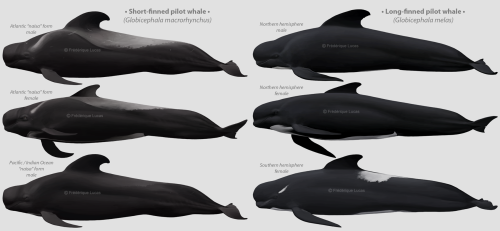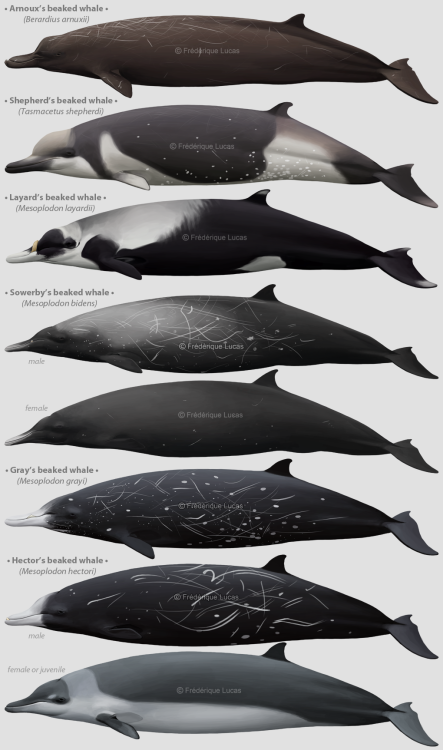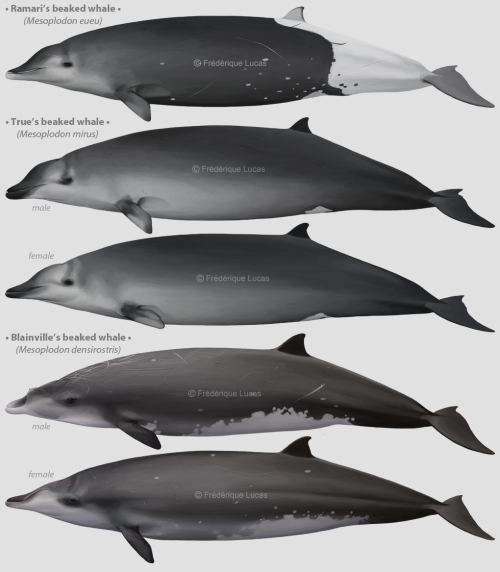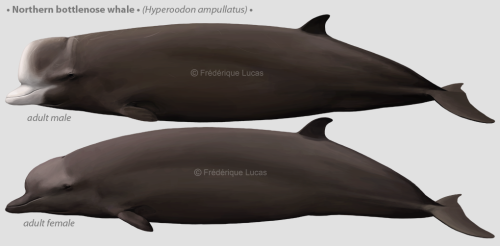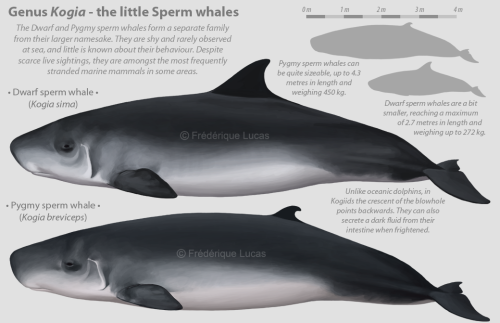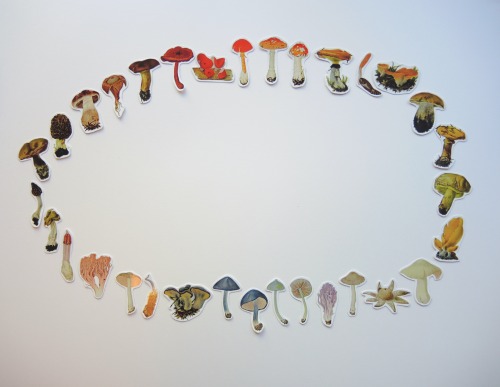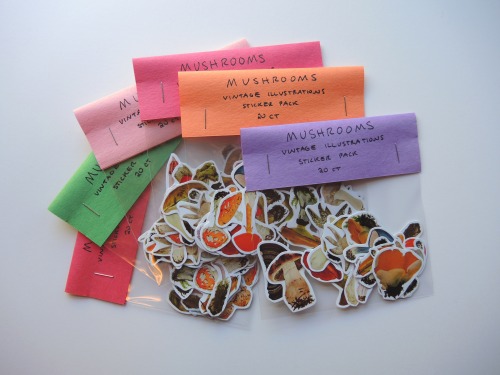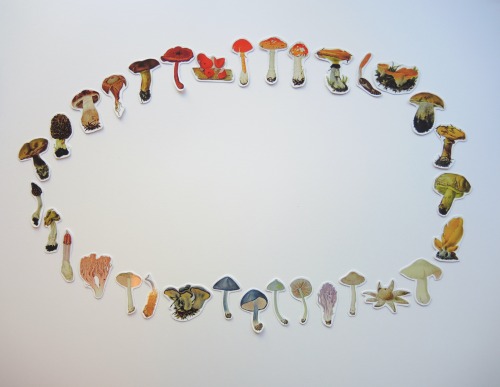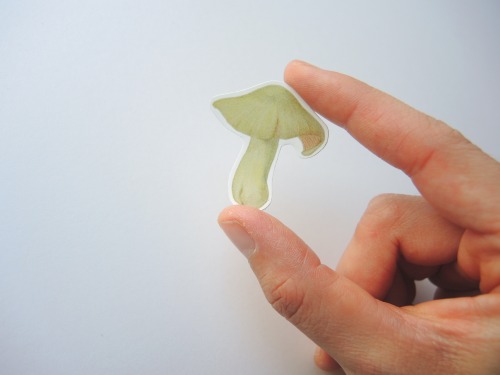#scientific illustrations
The Atlantic spotted dolphin - Stenella frontalis
This is without a doubt my favourite illustration for this project so far. I love Atlantic spotted dolphins, with their sociable personality, elegant faces and beautiful colouration - and these in particular. You see, while the Common bottlenose dolphin’s coastal and oceanic populations are best known, there’s more dolphins with a similar division amongst their ranks. Spotted dolphins (both the Atlantic and Pantropical) have offshore and coastal populations as well, which vary in colour.
In case of the Atlantic, coastal animals - like those found in The Bahamas - are most heavily spotted. Adults can gain so many spots over the years that in the end, their colour pattern is reversed. White above, black below. Illustrated however, is an oceanic-type Atlantic spotted dolphin; and they hold on to their stark white bellies. The amount of spots varies between individuals, some are quite heavily spotted, others snowy white below the sides - but never is the belly covered. The white spots are also finer than those in coastal animals, and while I painted my animal with quite a lot, some have no more than a fine dusting of white.
Exquisitely beautiful animals if you ask me, and I am immensely happy that the spotting finally turned out to my liking (painting spots is harder than it seems).
Post link
A plethora of pilot whales
The alliterations continue, as well as the uploading of illustrations from last year’s two big project. This time, pilot whales. A big and impressive relative of the killer whale, which come in two species: the Long-finned (Globicephala melas) and Short-finned (Globicephala macrorhynchus). Ironically pectoral fin length isn’t always a good identifier, but shape is a good call: in Short-fins the pectoral fins have a continuous sickle shape, whereas in Long-fins the pectoral fins have a single bend, and then taper out very straight.
Within the species there is diversity too. Long-finned pilot whales are the colder water species of the two, and thus their range is divided into a northern and southern population. Northern animals are quite plain black aside from the white anchor marking on their chest and belly. However Southern animals bear very striking white eye- and saddle patches, a bit reminiscent of killer whales.
Short-finned pilot whales live in warmer waters and Japanese fishermen had long known of two different types. Recent research showed these to be two distinct global subspecies: the “Shiho” form, living mostly in the Eastern Pacific but also off Northern Japan, and the “Naisa” form, living in the rest of the Pacific Ocean, as well as the Indian and Atlantic. They can be told apart by their saddle patch: the Naisa form has a long saddle patch reaching almost the end of the peduncle, whereas the Shiho form has a very short one. I only illustrated Naisa animals, but all pilot whales currently living at Seaworld are of the Shiho form and you can see the difference in saddle patch length.
Within the Naisa form there’s yet more differences. In the Pacific and Indian Ocean, Naisa’s have very muted colouration, as shown by the bottom illustration. It can be hard to even spot their saddle patches at all! However Atlantic animals are very brightly coloured with beautiful creamy markings sweeping up from behind their eye and into their prominent saddle patches.
Post link
A bunch of beaked whales
I did mention I got to paint a lot of beaked whales, right? ;) After the bottlenose whales here are, well, the others. I thought it was nice to put them all together, really makes you appreciate the wonderful diversity within this big family (and it saves you from ‘a beaked whale a day’ for the next 1.5 weeks). There’s too many to all discuss individually but I have some favourites:
Shepherd’s beaked whale was a joy to paint as they are one of my favourites. Their markings are so beautiful, and they are also unique in being the only beaked whale to have a full set of teeth. For very long their colour pattern was unknown (and oft presumed to have this streaky pattern) until in 2006(!) their real colouration was formally described. They are a beautiful, elegant and unique looking species.
Sowerby’s beaked whale provided a similar ‘aha’ erlebnis for me. Often illustrated as a medium gray throughout (which is certainly fitting for the females) some interesting photographs of adult males showed a rather distinctive light blaze between their blowhole and dorsal fin. In some males it was very subtle, but others had almost as much contrast as a Layard’s beaked whale - I chose to illustrate something in the middle. Very interesting and something I hope will be the subject of further study. Males and females also have funny white lips.
Ramari’s beaked whale can’t be overlooked as it is the youngest member of the family: only described three months ago, in October 2021. Previously known as the southern form of the True’s beaked whale, analysis proved they were a species all of their own. Very happy to have painted this one too, as the mysterious southern True’s with their shining white peduncles always intrigued me.
And lastly, I can’t not mention Blainville’s beaked whale becausetake a closer look at that snout. Any whale whose mouth somehow ends up above their eyes is worthy of an extra look I think. And the Layard’s beaked whale because they have always been my number 1 favourite beaker.
Post link
The Bottlenose Whales
Happy new year everyone! Sorry for the quiet, I’ve been busy finishing two big projects. One of the things I loved about both of them is how many beaked whales I got to paint! I’ve never had much chance to illustrate them, so it was high time to make up for that. And what better way to start off 2022 than with some big, thick, and CHONKY bottlenose whales?
The Northern bottlenose is the biggest - adults can reach almost 10 metres in length and weigh some 6 to 7 tons! While male beaked whales are famous for their tusks, Northern bottlenoses’ are tiny. Their huge, square heads are far more prominent, and indeed this is their choice of weapon: males will use it to headbutt each other in fights. Male Southern bottlenose whales appear quite different. Their melons are smaller and more forward facing - not quite the battering ram the northerners wear - and their bodies are completely covered in rake marks, revealing a different fighting strategy. Theirs is the traditional beaked whale way of going tusk-to-tusk. It’s been said that males can bear so many scars they look almost white from a distance.
And then comes the Longman’s beaked whale - not really a bottlenose whale pur sang, but rather a namesake based on looks. They are a surprisingly recent discovery: they were only identified in the early 2000′s! Before then mysterious tales of Southern bottlenose whales in tropical waters had intrigued scientists. Longman’s beaked whale was already known, but only from two skulls. No one knew what they looked like. It wasn’t until 2003 when two stranded whales were identified through DNA, and the species’ appearance was first described. People turned to the sightings of “tropical bottlenose whales”, and concluded they were one and the same.
It is often said Longman’s look like Southern bottlenose whales: both have a light-coloured melon. However this only goes for immature Longman’s, adults look very different. Females become uniform grey, with a lighter, often orange-tinged face. Males are more of an enigma - one study observed a few ghostly light grey animals surfacing amongst a pod. They assumed these could be adult males. Sadly I can’t find any photos besides the grainy black-and-white ones this paper holds, and to my knowledge no adult male has ever stranded. So until then their appearance (and my illustration) is something of a guess. There’s still so much to learn about these animals.
Post link
GenusKogia- the little Sperm whales
And another infographic. I’m really liking this way of showing off work, feels a bit more visually appealing than just bare illustrations. This time it’s the turn of the mini sperm whales. Even though they look somewhat similar to Sperm whales, they are in a separate family, Kogiidae. It’s interesting how often they strand, given their low sighting rate at sea. They may simply be overlooked or misidentified: they tend to keep a low profile, and aren’t very demonstrative (though Dwarf sperm whales occasionally breach).
Even when stranded, the two species can be surprisingly difficult to identify. The most obvious difference lies in the size and position of the dorsal fin. A useful tool on ‘textbook’ individuals, but some animals have a relatively big/small dorsal fin for their species, positioned more in the middle. Another ID tool lies in their markings. Quite noticeable is the ‘false gill’ both these species have - a possible form of Batesian mimicry to look like a shark. In the Pygmy sperm whale this gill mark takes a sort of bracket shape, with a recurved bottom, while in the Dwarf it tends to be straight. There might be a slight difference in overall body markings as well, and from what I’ve seen Pygmies seem to have a somewhat longer head than Dwarfs, but this would be hard to use in the field. Interestingly, some Pygmy sperm whales turn up with more contrasting colouration and speckles all over. Perhaps older individuals? Also, both have these dark ‘eye patches’ which I think is very cute. I hope you enjoy and maybe learn something new about these mysterious whales!
Post link
The Not-Quite-Killer whales
False killer whale (Pseudorca crassidens) & Pygmy killer whale (Feresa attenuata)
So after the killer whale infographic, here’s a.. non-killer whale infographic (can anyone tell I’m into infographics??). Not much info on this one but I though it would be nice to show these together: two species named after the infamous Orcinus orca, without really being cut from the same stuff. It comes from the skulls mostly. All three species are short-snouted and large-teethed, and especially False killer whale skulls look very similar. Pygmy killer whales have this funny thing where the left jaw is bigger and often contains one more tooth than the right. They’ve also proven quite aggressive towards humans and other dolphins when put under stress, even being described as “growling like a wolf”, which might have contributed to the ‘killer’ name too.
Although these are called ‘blackfish’, closer inspection reveals animals that are anything but. Pygmy killer whales, like Melon-headed whales, bear a rather noticeable grey with a darker cape. They are surprisingly elegantly marked animals, something not many photos reveal. Sightings are relatively scarce - prior to 1954 the species was known from just two skulls(!!) - and they may be rare, or easily confused with others. False killer whales hide their markings better; harsh light makes them appear quite black indeed. But gently lit underwater scenes reveal they wear, in fact, quite familiar attire. Their markings are not unlike those of bottlenose dolphins, following a triparte palette.
These two are again for the current commission. It was a joy to paint a False killer whale again (it had been a while and they are a big favourite), and the first time painting the Pygmy, which was lots of fun. I hope you’ll enjoy too.
Post link
when i worked at a campsite, i used to count how many moths i could see in the toilets when i did the early morning clean and then go home and identify them
Post link
In honor of Earth Day tomorrow, I’m holding a flash sale in my online mushroom sticker shop! Starting now, use code EARTHDAY to get 15% off your entire order! Code is valid through Earth Day (April 22). My online shop link is here.
Post link
Good morning! I’ve just added a new listing to my online shop! You can add on a surprise randomized vintage scientific illustration mushroom sticker if you want a little bonus mushroom! My shop link is here if you’re interested!


Here’s a pretty good display of all the possible sticker types available in the sticker packs! Sticker packs are available in the online shop! Link is here.
Post link




